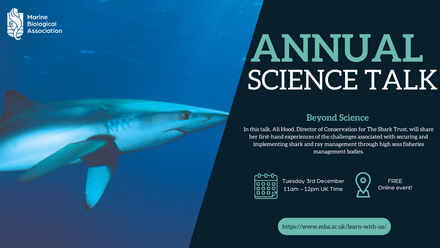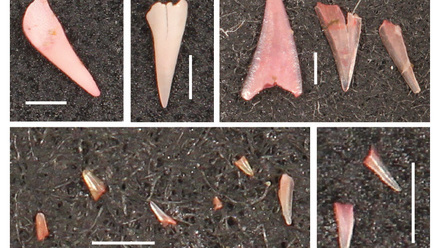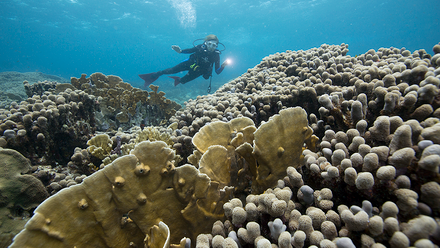It was in the late summer of 2016 that mysterious circling groups of basking sharks started to appear at the surface off western Ireland. They were strange because the circle formations were made up of large sharks that were not feeding. It is usual at that time of year to see basking sharks surface feeding on zooplankton. Instead, individuals within these groups were slowly swimming and following each other, such that the group formed a rotating ring of sharks that appeared to remain spinning for hours. What were the groups doing?
Over the next 6 years, a dedicated team of filmmakers and scientists, including ourselves, recorded this behaviour, both from the air and underwater, to begin investigating the function of these enigmatic assemblages.
Circle formations
At up to 12 m long and over 5 tonnes in weight, the basking shark Cetorhinus maximus is the world’s second largest fish. Living in temperate to warm-temperate waters all over the world, it is frequently seen near coasts during warmer months, surface feeding on zooplankton. Although usually a solitary shark, the basking shark does form loose aggregations when foraging. These form as they move up gradients in zooplankton abundance, leading each shark to richer food patches, which have been observed to support many tens of individuals.
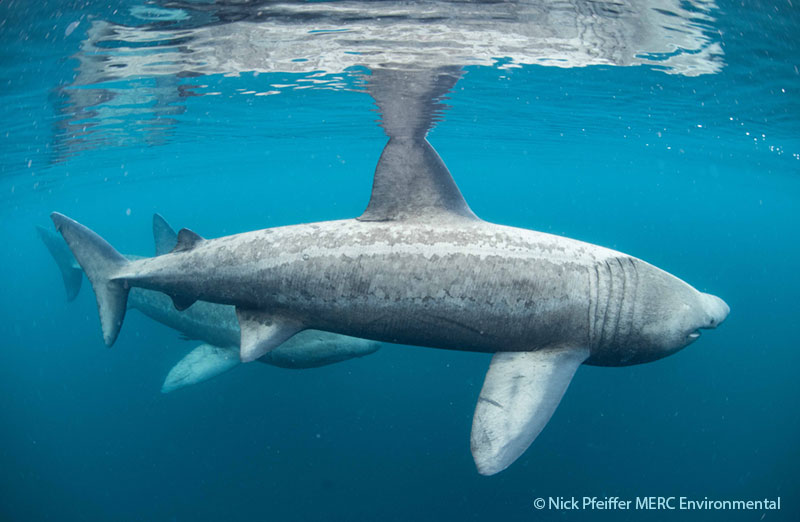
A 'torus' of basking sharks September 2021 5 km off Kilkee, County Clare, Ireland. © Nick Pfeiffer MERC Environmental.
Since the early 1990s, we have studied the behaviour and ecology of the basking shark in the northeastern Atlantic, mapping its occurrence, satellite tracking seasonal movements, determining foraging tactics, switches in vertical feeding patterns, apparent social behaviour, measuring swimming speeds, and estimating energy expenditure, among many other investigations. But the basking shark circles in the sea were like nothing we’d encountered or studied before.
Circling formations of basking sharks have been observed from aircraft several times over the past 40 years in the northwestern Atlantic. Similar circles had not previously been formally documented in the northeast Atlantic, which is perhaps surprising, given that it is a region well known for basking sharks. Up-close encounters with basking sharks have been recorded since at least the mid-18th century off the UK and Ireland, as a result of organized fisheries for their liver oil, meat, and fins. A more recent increase in reported sightings has followed the rise in ocean ecotourism, recreation, and scientific studies. But no circles were reported over all that time. So why were circles observed in the northwest but seemingly not in the northeast Atlantic? Did this indicate differential use of the North Atlantic by basking sharks for different behaviours or life-history events?
First sight
An old proverb tells us that good things come to those who wait. It isn’t wrong. In August 2016, an incredible opportunity arose to study circling basking sharks up close for the first time. Two different circles of non-feeding basking sharks were encountered south of the Aran Islands, County Galway, and were filmed over several hours. The first encounter was filmed by Ken O’Sullivan and Kev Smith of SeaFever Productions, and a second by Nick and Brianna Pfeiffer and Paul Connery of MERC Ecological Consultants. For basking shark researchers, it was like waiting for buses: nothing for ages then two at once: the circles were just 9 days and a few kilometres apart.
These first two circles yielded fascinating new insights. The two field teams did a masterly job of video-recording successive rotations of sharks moving within the circles, to enable sexes and individuals to be identified. The first group was a slowly spinning formation of 16 sharks resembling a three-dimensional layered structure we termed a ‘torus’. It comprised both non-feeding females and males; the males were identified from the presence of ventral claspers in the pelvic region which are used to transfer sperm to females. The sharks were distributed in the torus in three separate layers, from the surface to 5–10 m depth. The torus diameter was only 23 m across, but was made up of sharks that were about 7–9 m long, which meant that these giants were very close to each other while they circled. Indeed, the recordings showed the sharks displaying close following, parallel and echelon swimming, and close flank approach, which are all behaviours consistent with courtship seen in other shark species.
Ken, Nick, and their colleagues also recorded the environmental conditions at the time they saw the toruses. They found the circles were in waters rich in zooplankton and attended by other marine megafauna such as humpback whales and bluefin tuna. We later found that toruses were located close to zooplankton-rich thermal fronts (boundaries between water masses of different temperature), indicating that they likely formed in late summer when basking sharks— already aggregated within plankton patches for feeding—switched to non-feeding behaviour.
Annual circles
The research team at the Marine Biological Association led by one of us (D.W.S.) began analysing those basking shark torus videos in 2017. Soon after, though, further basking shark toruses were seen off County Clare, western Ireland, which opened up the opportunity to gain a much deeper understanding of the gatherings. By late autumn 2021, there were 19 toruses for us to analyse.
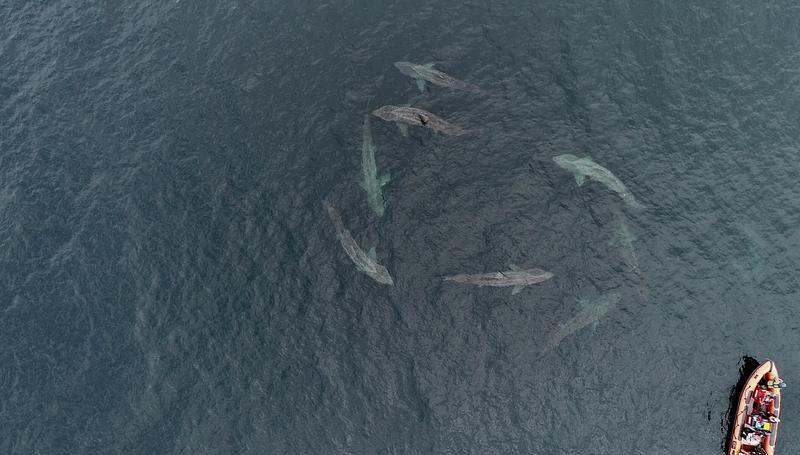
It seemed very likely that torus behaviour was annual off western Ireland, with toruses seen in 2016, 2020, 2021, and 2022. Each circling group comprised a maximum number of between six and 23 sharks. The groups seen were all located between 6 and 20 km from the coast in Galway Bay, between the Aran Islands and west and north of Loop Head to the south, suggesting that particular environmental conditions led to circles occurring at the surface rather than at depth, where we speculate they generally occur more frequently (explaining the lack of direct observations over the years). MBA team members Freya Womersley, Nick Humphries, and Nuno Queiroz analysed the torus locations using satellite remote-sensing images and modelled temperature data. They confirmed that toruses were located near thermal fronts, which are known to be highly productive waters that aggregate zooplankton in high densities.
Interestingly, the torus locations were consistent between years at the broad scale. However, at the local scale, toruses in 2020 were generally located further offshore than they were in 2021. The field team led by S.D.B. found that within each daily observation period, there was often more than one torus present in the local area, indicating multiple toruses which had formed separately. The annual occurrence of the toruses in similar locations off the coast, and multiple circles of non-feeding sharks being formed on the same day, raised the possibility that these were groups engaging in annual courtship reproductive behaviour.
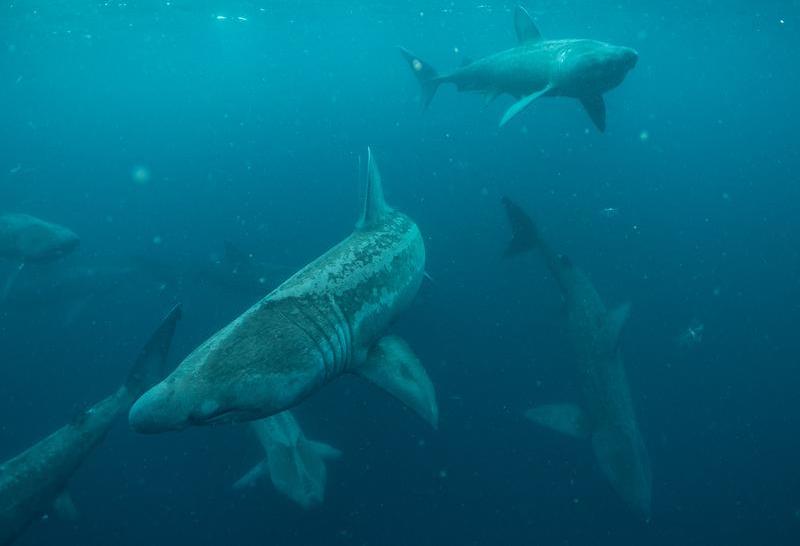
A torus of 16 basking sharks, September 2021, 5 km off Kilkee, County Clare, Ireland. © Nick Pfeiffer MERC Environmental.
Courtship behaviour?
A distinctive feature we saw across all circling groups was that the individuals present were consistently massive, even by basking shark standards. Large body sizes of sexually mature females and males are expected if a primary function of torus behaviour is courtship. So, to test this, we estimated the body lengths of sharks from airborne drone video images by comparing them to the length of our research vessels. We also made use of Ken’s freediving fins—which, at a metre long, were a novel, if somewhat scientifically unconventional, scale bar for estimating shark lengths from the drone—when he observed them at the surface outside the torus itself.
We were able to estimate the body lengths of 27 basking sharks in five different toruses with good accuracy: they ranged from 5.4 to 9.5 m, with an average length of 7.3 m. Although not precisely known, male basking sharks are thought to become sexually mature at around 5 m and females around 7 m, so the lengths of sharks in toruses overlapped the lengths expected at sexual maturity for males and for some females of this species. Within a torus, there were roughly equal numbers of mature female and male sharks of more than 7 m in total length. Additionally, the claspers of males were also large, and consistent with those measured for mature males in previous studies. In the case of many males present, claspers also carried apparent recent abrasions indicative of sexual activity.
Male biting of the female’s pectoral fin is another common behaviour in sharks prior to and during mating. From the underwater videos, it was evident that most females bore abrasion marks on their pectoral fins, although we did not witness pectoral biting during the hours that the toruses were monitored. The absence of similar pectoral fin marks on male basking sharks in toruses supported the possibility that biting had occurred during mating activity.
There was one fascinating discovery from the 2016 and 2021 toruses that, for us, really sealed the deal that we were seeing basking shark courtship behaviour. The teams noticed that female basking sharks had paler skin colouration than the males they were closely associating with during parallel and close-following behaviours, which are known courtship behaviours in sharks. The colour differences between females and males that we saw are consistent with with sex differences in colour changes seen in other shark species during courtship and mating, such as nurse sharks from tropical and sub-tropical reefs. It was at this time in our study that we heard from Shane Wasik of Basking Shark Scotland, who had seen three basking sharks circling in western Scottish waters, with the male in that group visibly darker in body colour than the females. We realized then that what we were studying off Ireland was also likely to be happening in UK waters, and that the accumulating evidence was pointing to the circles having a courtship behaviour function.
Slow-motion speed dating
As we started looking deeper into the individual behaviours of sharks within a torus, especially when they interacted with other sharks, another striking finding jumped out at us. A feature of shark movement within a torus is that they swim slowly, at about 0.5 m/s (1 knot), usually close to one another. At first, we thought that this slow rotation would mean that individuals ‘held station’ alongside others for long periods of time.
Using simultaneous videos of the torus from the air and underwater, the MBA’s Emily Southall identified the females and males in the group and tracked all their movements and close interactions. She discovered that individual basking sharks associated with most other torus members rapidly (within minutes), indicating that toroidal behaviours facilitated multiple interactions, like slow-motion ‘speed dating’. Close study of 14 individually identified sharks (including six females and four males) revealed that each shark associated with most other sharks in the torus within 10 minutes. We counted 13 of the 14 sharks associating with between 10 and 13 other individuals. Thus, there was no apparent sex difference between females and males associating with other individuals, and no individual of either sex was observed associating solely with a single individual of the opposite sex. For example, female 6 associated with all 13 other individuals in the torus, while male 9 associated with eight of the 13 other sharks. There were repeat associations within the observation period too, with female 6 associating with male 10 three separate times in 8 minutes. The emerging picture was of a torus being a circling group, enabling dynamic mixing of females and males.
Harassment of females by males was never seen, nor male mate-guarding behaviour, which supports the dynamic mixing idea. Indeed, most large males associated with the largest female present, and one of the largest males swam under every identified female but none of the males, perhaps to assess mating receptivity from chemical signals secreted by females. Effective recognition and assessment of potential mates is probably facilitated through the dynamic structure of a torus. Large numbers of males and females rapidly mixing, such that most individuals have associated with most other individuals, may be an efficient mechanism that confers optimal information exchange about sharks’ fitness potential. Breaching behaviour may also enable information exchange (Box 1).
Box 1 – Leaping sharks
Basking sharks leaping fully clear of the water, known as breaching behaviour, was associated with 53% of toruses. Basking sharks have long been documented to breach and it’s a magnificent sight, albeit also a slightly worrying one when it occurs within a few metres of your boat. But its function remains obscure. It has been suggested to be a behaviour to remove external parasites, as well as perhaps a part of courtship. We didn’t see breaching in all toruses, so is it part of courtship? Breaching could act to announce an individual’s readiness to mate, or as a courtship display perhaps to indicate fitness. It might be expected that if breaching was a regular component of basking shark courtship, then it may be more frequent in larger toruses where competition for mates is likely to be more intense. We found a slightly greater tendency for breaching in larger toruses. Until this idea can be more rigorously tested in further studies, we cannot discount that it may indeed serve several behavioural functions other than courtship.
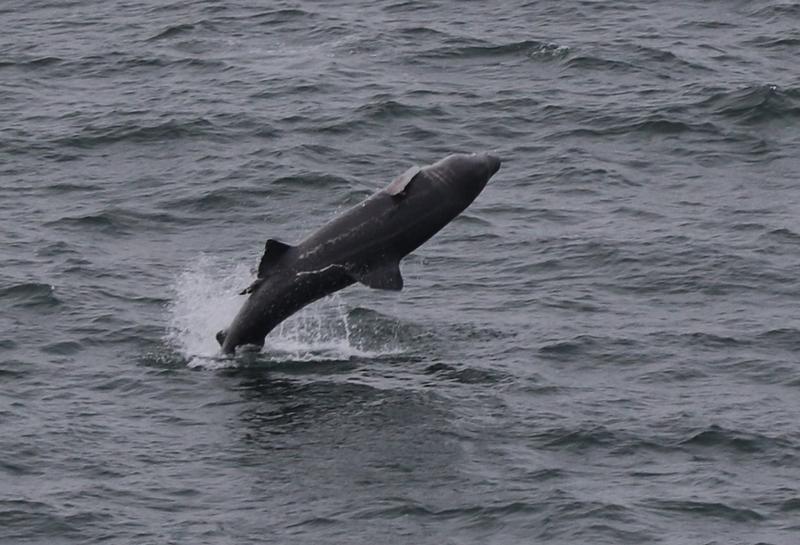 Breaching basking shark off Loop Head, County Clare, Ireland, 27 August, 2021.
Breaching basking shark off Loop Head, County Clare, Ireland, 27 August, 2021.
Subtle, dance-like interactions
Some of the most intriguing behaviours were also mesmerizing to watch. They were nothing like the usual behaviour we were used to seeing during the hundreds of days spent studying basking sharks foraging in loose aggregations. The interactions in the toruses appeared dance-like, with subtle signals likely being made between sharks during those encounters.
We observed individual sharks touching the pectoral fins or bodies of other individuals. Also, both males and females engaged in parallel swimming with the opposite sex, and were seen to exhibit a whole-body dorso-ventral flexion, resulting in head ‘nodding’ and lifting of the tail fin. In one notable case, nodding behaviour was observed in a female that was parallel swimming to the right of a male. This example was notable because as the female displayed this nodding behaviour, the male rolled onto its left side with its underside facing towards the female, simultaneously undertaking a vertical dive shorter than its own body length before resuming normal swimming in a new direction, as if to try to lead her away. It didn’t seem as though the female followed the male in the new swimming direction. All these interactions were conducted at an adagio tempo, adding to its mesmeric effect on us as observers (follow link below for torus and behaviour videos).
Interestingly, we only saw male or female body rolling to expose the ventral area to a following shark in large toruses with more than 16 individuals. It is possible that the larger toruses take longer to form, presumably by progressively aggregating or actively attracting greater numbers of receptive males and females. Sharks may be attracted to toruses and locate them via olfactory trails of sex pheromones released into the water by sharks that are already there. A combination of larger numbers of mature basking sharks, combined with the slower rotation speed of larger toruses, may indicate a later stage of courtship prior to mate pairing and copulation. Therefore, the rolling behaviour could be a first attempt by either sex to lead away a potential mate to form a pair, ahead of the act of mating. Mating behaviour itself was not seen by us in toruses and, to our knowledge, has not been formally described for the basking shark in any other context, either. It remains yet another mystery of the basking shark that waits to be slowly revealed.
Conservation implications
Our 6-year collaborative study indicates that northeastern Atlantic coastal waters are important for courtship reproductive behaviour of endangered basking sharks. Within these, productive thermal front habitats provide the right conditions for feeding aggregations to form in spring and summer, prior to basking sharks switching to non-feeding in late summer to form toruses.
But courtship toruses—occurring in the same places off Ireland in late summer each year—are potentially exposed to collisions with commercial shipping, marine leisure traffic, and the effects of coastal developments as part of the burgeoning offshore renewables sector. Threats include entanglement, anthropogenic noise, and the effects of electromagnetic fields from cabling. To further promote the recovery of basking shark populations from historical overfishing, and to protect them from contemporary threats of human activities, the habitats supporting basking shark courtship toruses—a very important and potentially sensitive period in their life-cycle—will require additional protection measures. In October 2022, the basking shark became a protected species in Ireland when it was listed under Section 23 of the Wildlife Act, which seeks to protect its breeding and resting places. Specific spatial management measures will be required to safeguard basking shark breeding areas, as human activities in these coastal seas are predicted to increase in the coming years.
David W. Sims
Marine Biological Association, and University of Southampton, UK. Email: dws@mba.ac.uk
Simon D. Berrow
Irish Basking shark Group, and Atlantic Technological University Galway, Ireland. Email: simon.berrow@iwdg.ie
For more on David's shark research, listen to The Marine Biologist podcast.
Further reading
Sims, D.W., Berrow, S.D., O’Sullivan, K.M., Pfeiffer, N.J., Collins, R., Smith, K.L., Pfeiffer, B.M., Connery, P., Wasik, S., Flounders, L., Queiroz, N., Humphries, N.E., Womersley, F.C., and Southall, E.J. 2022. Circles in the sea: Annual courtship ‘torus’ behaviour of basking sharks Cetorhinus maximus identified in the eastern North Atlantic Ocean. Journal of Fish Biology 101, 1160-1181. (Open Access) https://onlinelibrary.wiley.com/doi/full/10.1111/jfb.15187

